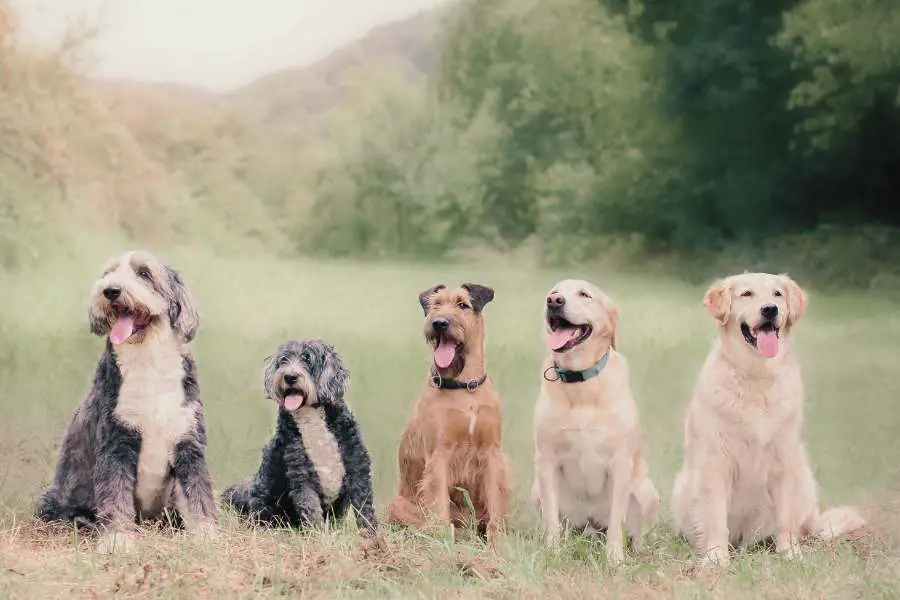When considering good dog breeds for kids, it’s essential to choose breeds known for their gentle and friendly nature. Breeds such as Labrador Retrievers, Golden Retrievers, Beagles, and Poodles are typically great choices for families with children. These breeds are known for their playful demeanor, patience, and loyalty, making them ideal companions for kids of all ages. However, it’s important to remember that individual dog temperament can vary, so proper socialization and training are crucial regardless of the breed.
Thinking of adding a furry friend to your family?
Choosing the right dog breed for kids is key to a happy home.
Discover top breeds, training tips, and socialization strategies to help you find the perfect pup for your children!
Table of Contents
Factors to Consider When Choosing a Dog Breed for Kids
When it comes to selecting a dog breed for your family, especially if you have children, there are several key factors to keep in mind.
Let’s dive into the considerations that can help you find the perfect furry companion for your little ones.
1. Temperament and Personality Traits
The temperament of a dog is crucial when choosing a breed that will be around children.
Look for breeds known for their patience, friendliness, and playfulness.
Some examples of dog breeds with great temperaments for kids include Golden Retrievers, Labrador Retrievers, and Beagles.
These breeds are typically gentle and sociable, making them ideal playmates for children.
2. Size and Energy Level
The size and energy level of a dog breed are important factors to consider, especially in households with kids.
Smaller breeds like Cavalier King Charles Spaniels or Beagles may be more suitable for families living in apartments or homes with limited space.
On the other hand, larger breeds like Bernese Mountain Dogs or Boxers may thrive in homes with a yard where they can run and play freely.
3. Maintenance and Grooming
Another crucial consideration is the grooming requirements of the dog breed.
Breeds like Poodles or Bichon Frises have hair that grows continuously and requires regular grooming to prevent matting.
On the other hand, breeds like Labrador Retrievers or Beagles have short coats that are easier to maintain.
Consider how much time and effort you can dedicate to grooming when choosing the right breed for your family.
4. Trainability and Intelligence
When selecting a dog breed for kids, it’s essential to consider the trainability and intelligence of the breed.
Breeds like Border Collies or German Shepherds are highly intelligent and excel in training, making them great for families looking to engage their dogs in activities like obedience training or agility.
On the other hand, breeds like Bulldogs or Basset Hounds may be more independent and less eager to please, requiring a different training approach.
5. Allergies and Shedding
If your child or family members have allergies, it’s essential to choose a hypoallergenic dog breed that sheds less dander.
Breeds like Poodles, Bichon Frises, or Maltese are considered hypoallergenic and may be more suitable for families with allergies.
Keep in mind that no dog breed is entirely hypoallergenic, but some breeds are less likely to trigger allergic reactions compared to others.
By considering these factors when choosing a dog breed for your kids, you can set your family and furry friend up for a harmonious and joyful relationship.
Remember, every dog is unique, so take the time to research and meet different breeds to find the perfect match for your family dynamics and lifestyle.
The Top 4 Good Dog Breeds for Kids
When it comes to choosing a furry companion for your children, you want a dog breed that is gentle, patient, and adaptable.
After conducting thorough research, I’ve found that four dog breeds stand out as excellent choices for kids: Labrador Retrievers, Golden Retrievers, Beagles, and Bulldogs.
1. Labrador Retrievers

Labrador Retrievers are consistently ranked as one of the best dog breeds for families, and for good reason.
Known for their friendly and outgoing nature, Labradors are extremely patient with children and other pets.
They are also highly intelligent and easy to train, making them a perfect fit for families with young kids.
2. Golden Retrievers

Golden Retrievers are another popular choice for families with children.
These gentle giants are known for their calm demeanor, loyalty, and loving nature.
They are great playmates for kids, enjoying activities like fetch and swimming.
Golden Retrievers are also highly trainable, making them an ideal family pet.
3. Beagles

Beagles may be small in size, but they have big personalities.
Known for their friendly and curious nature, Beagles are excellent companions for children.
They are energetic and playful, always up for a game of chase or a walk in the park.
Beagles are also known for their loyalty and affection towards their family members.
4. Bulldogs

Despite their tough appearance, Bulldogs are actually very gentle and affectionate dogs, especially towards children.
Bulldogs have a calm and easygoing temperament, making them great companions for kids of all ages.
They don’t require a lot of exercise and are content to lounge around the house, making them perfect for families living in smaller spaces.
when choosing a dog breed for your kids, it’s important to consider their temperament, size, and energy levels.
Labrador Retrievers, Golden Retrievers, Beagles, and Bulldogs are all excellent choices that combine a friendly disposition with a love for play and companionship.
By welcoming one of these breeds into your home, you’re not just getting a pet – you’re adding a loyal and loving member to your family.
Remember, a dog is not just a pet; they become a part of your family and bring joy, love, and companionship into your life.
Training Tips for Ensuring a Positive Relationship Between Kids and Dogs
As a parent looking for the perfect furry companion for your children, ensuring a harmonious relationship between kids and dogs is paramount.
Here are some training tips to help foster a positive bond between your little ones and their canine pals.
1. Start Early with Proper Socialization
To set the foundation for a strong bond between kids and dogs, it’s crucial to start early with proper socialization.
Introduce your dog to various environments, people, and other animals from a young age.
This will help your dog become accustomed to different situations and reduce the likelihood of behavioral issues.
2. Teach Kids How to Interact Safely
Educating your children on how to interact safely with dogs is key to preventing accidents and ensuring a positive relationship.
Teach them to approach dogs calmly, avoid sudden movements, and always ask for permission before petting a dog.
Encouraging respect and empathy towards animals will go a long way in fostering a healthy connection.
3. Supervise Interactions
No matter how well-behaved your dog is, it’s essential to supervise all interactions between kids and dogs.
Accidents can happen in a split second, so keeping a watchful eye on their interactions will help prevent any mishaps and reinforce positive behavior.
4. Use Positive Reinforcement
Positive reinforcement is a powerful tool in training both dogs and children.
Rewarding good behavior with praise, treats, or toys encourages desirable actions and strengthens the bond between kids and dogs.
Conversely, avoid using harsh punishments, as this can lead to fear and aggression in dogs.
5. Establish Boundaries
Setting clear boundaries for both kids and dogs is vital for a harmonious relationship.
Teach children to respect the dog’s space, food, and toys, and ensure that the dog has a safe retreat area where they can go if they need some alone time.
Consistency in enforcing these boundaries will help prevent conflicts and create a happy environment for both parties.
6. Include Kids in Training
Involving kids in training sessions can be a fun and educational experience for both the child and the dog.
Simple commands like “sit,” “stay,” and “come” can be taught to children to help them communicate effectively with the dog.
This not only improves obedience but also strengthens the bond between kids and dogs through shared activities.
By implementing these training tips, you can foster a positive relationship between kids and dogs based on trust, respect, and understanding.
Remember, patience, consistency, and love are key ingredients in nurturing a lifelong friendship between your children and their four-legged companion.
Socialization Strategies for Introducing Dogs to Children
When it comes to choosing a dog breed for your kids, socialization is key to ensuring a harmonious relationship between the furry friend and the little ones.
Here are some effective strategies to help introduce dogs to children in a positive and safe manner:
1. Slow and Steady Wins the Race
Introducing a dog to children should be a gradual process.
Rushing the introduction can lead to anxiety and fear for both the dog and the kids.
Start with short, supervised interactions and gradually increase the time as the dog and children become more comfortable with each other.
2. Teach Kids the Right Way to Interact
It’s essential to educate children on how to approach and interact with dogs properly.
Teach them not to approach a dog while it’s eating or sleeping and to always ask permission before petting the dog.
Additionally, show them how to recognize signs of stress or discomfort in the dog’s body language.
3. Positive Reinforcement
Use positive reinforcement techniques to create a positive association between the dog and the children.
Reward good behavior from both the dog and the kids with treats, praise, and affection.
This helps build trust and strengthens the bond between them.
4. Supervision is Key
Always supervise interactions between dogs and children, especially during the initial stages of their relationship.
By closely monitoring their interactions, you can intervene if necessary to prevent any negative encounters and ensure the safety of both the dog and the kids.
5. Encourage Respect and Boundaries
Teach children to respect the dog’s boundaries and signals.
Emphasize the importance of allowing the dog to have its own space when needed and not to disturb or tease the dog.
Establishing clear boundaries from the start helps prevent misunderstandings and reduces the risk of conflicts.
6. Create Safe Spaces
Provide the dog with a designated safe space where it can retreat to when it needs a break from the kids.
This could be a cozy corner with a bed or crate where the dog can relax undisturbed.
Encourage the children to respect the dog’s safe space and not to bother the dog when it’s there.
By following these socialization strategies, you can help foster a positive and harmonious relationship between dogs and children, ensuring a safe and enjoyable experience for both parties.
Remember, patience, consistency, and positive reinforcement are key to successful introductions and long-lasting bonds.
Final Thoughts
When it comes to choosing the perfect furry friend for your family, consider the factors that best suit your lifestyle and the needs of your children.
Labrador Retrievers, Golden Retrievers, Beagles, and Bulldogs are among the top dog breeds known for their friendly and gentle nature, making them ideal companions for kids.
Remember, every dog is unique, so take the time to properly introduce them to your family and ensure they receive the necessary training and socialization.
By following these tips, you can lay the foundation for a harmonious relationship between your children and their new four-legged friend.
So why wait?
Start exploring these wonderful breeds and get ready to bring home the perfect pup for your family today!

